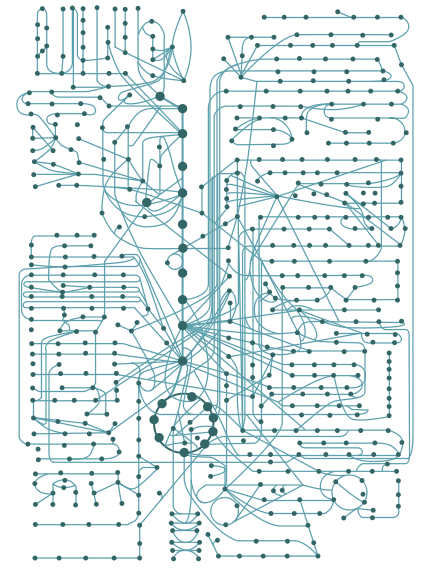The course includes the topics:
Animal physiology
Plant physiology
Animal Developmental Biology
Plant Developmental Biology

METABOLISM AND REGULATION
A course designed to Post graduates in Biochemistry(CCSS) offered by Department of Life Sciences university of Calicut, who are having an under graduate experience in Biochemistry and intermediary metabolism.
Overview of metabolism
Cells
are constantly carrying out thousands of chemical reactions needed to
keep the cell, and your body as a whole, alive and healthy. These
chemical reactions are often linked together in chains, or pathways. All
of the chemical reactions that take place inside of a cell or an organism are
collectively called the metabolism.
To
get a sense of the complexity of metabolism, let's take a look at the
metabolic diagram below. To me, this mess of lines looks like a map of a
very large subway system, or possibly a fancy circuit board. In fact,
it's a diagram of the core metabolic pathways in a eukaryotic cell, such
as the cells that make up the human body. Each line is a reaction, and
each circle is a reactant or product.
Abstract
diagram representing core eukaryotic metabolic networks. The main point
of the diagram is to indicate that metabolism is complex and highly
interconnected, with many different pathways that feed into one another.
Image credit: "Metabolism diagram," by Zlir'a (public domain).
In
the metabolic web of the cell, some of the chemical reactions release
energy and can happen spontaneously (without energy input). However,
others need added energy in order to take place. Just as you must
continually eat food to replace what your body uses, so cells need a
continual inflow of energy to power their energy-requiring chemical
reactions. In fact, the food you eat is the source of the energy used by
your cells!
To
make the idea of metabolism more concrete, let's look at how metabolic
processes that are crucial to life on earth: those that build sugars, proteins, Lipids Nucleic acids
and those that break them down, and how these processes are regulated in an orderly fashion.
- Teacher: Dr. B S Harikumaran Thampi



